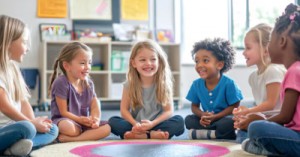The relationship between families and educators forms the backbone of a supportive environment for children’s growth. When these partnerships are strong, they create a continuity of care and shared values that empower children to thrive both academically and emotionally. The following article provides information on Strategies For Building Relationships Between Families and Educators, How Relationships Influence Positive Outcomes For Children and more.
Open communication between families and educators fosters a collaborative problem-solving atmosphere. When parents and teachers share insights about a child's unique needs and progress, strategies can be tailored to support that child's academic journey and emotional development more effectively. This dynamic exchange not only boosts academic outcomes but also promotes social skills, resilience, and a sense of accountability in children, as they learn to connect and interact within diverse social contexts .
In addition, when families and educators work together, they create a cohesive community network that extends beyond the classroom. This network can support students through various school and community activities, enhancing the child’s sense of belonging and reinforcing positive behavior. The ripple effect of these strong relationships can influence everything from classroom climate to long-term life skills, ensuring that children grow up in environments where their whole well-being is recognized and nurtured.
Strategies For Building Relationships Between Families and Educators
Building strong relationships between families and educators is essential for creating a supportive environment that nurtures every child’s academic, social, and emotional development. Let’s explore some key strategies that have proven effective:
1. Establish Consistent and Open Communication
Regular, clear, and two-way communication forms the foundation of trust. Educators can set up daily greetings, schedule routine parent-teacher conferences, and create digital or physical notice boards where families can access updates about classroom happenings. This ongoing dialogue not only keeps families informed but also creates an avenue for them to share their observations and concerns, thereby ensuring that the child’s learning environment is consistent across both home and school.
2. Adopt a Strengths-Based Approach
A strengths-based approach focuses on celebrating each child’s unique abilities rather than solely addressing challenges. When educators and families highlight a child’s strengths, they collectively foster a positive narrative around the child’s learning journey. This strategy involves careful reflection, inquiring about family insights, and framing conversations around positive progress. The approach not only builds the child’s confidence but also reinforces shared goals between the family and the educator.
3. Practice Active Listening
Active listening means being fully present in each conversation, validating the family’s experiences and opinions, and ensuring their voices are heard. When educators paraphrase what family members have shared, it confirms that their input is both respected and valued. This empathetic approach helps bridge any gaps in understanding and sets the stage for more effective collaboration in addressing each child’s needs.
4. Take Informed Action
Once the educator and family have shared insights about a child’s progress or challenges, the next step is to translate that dialogue into actionable strategies. Informed action means tailoring interventions based on the shared understanding of the child’s needs. Whether it involves modifying classroom practices or recommending supportive resources at home, this strategy makes the partnership dynamic and responsive, ensuring that the child’s development is continuously supported.
5. Create Inclusive Engagement Opportunities
Inviting families to be active participants in their child’s education builds a strong, collaborative community. Participation can range from volunteering in the classroom and joining parent-teacher committees to attending events and community gatherings. These activities deepen the relationship by breaking down barriers and making each family feel like a valued member of the learning community. Recognizing and respecting the diverse cultural backgrounds and perspectives of each family further strengthens these bonds and helps tailor the learning environment to meet every child’s needs.
How Relationships Influence Positive Outcomes For Children
The relationship between families and educators is a cornerstone of a child's development and learning journey. When families and educators collaborate effectively, children benefit in numerous ways:
-
Enhanced Emotional Well-being: Positive relationships create a sense of security and belonging for children. When families and educators work together, children feel supported both at home and in their educational environment.
-
Improved Academic Outcomes: Research shows that children who experience strong partnerships between their families and educators are more engaged in learning and achieve better academic results.
-
Consistency in Learning: Collaboration ensures continuity between home and school, allowing children to experience consistent learning approaches and values.
-
Development of Social Skills: Children learn to build relationships and interact positively with others when they see their families and educators modeling respectful and collaborative behavior.
-
Support for Individual Needs: Families and educators can share insights about a child's unique needs, enabling tailored support that fosters growth and development.
By weaving these strategies into everyday practice, educators can create a vibrant network of care and collaboration that directly translates to positive outcomes for children.
Further Reading
Forming Relationships With Children In Childcare
Strategies To Build Relationships With Children
Building Relationships with Families and Co-Workers
How To Achieve Quality Area 5
Positive Interactions With Children







 As an Educator in Australia, your pay rate falls under the Children’s Services Award 2010. This award states the minimum amount that an employer can
As an Educator in Australia, your pay rate falls under the Children’s Services Award 2010. This award states the minimum amount that an employer can When working as a qualified Early Childhood Teacher (with a university degree) within a service, your rate of pay will come from the Educational Services
When working as a qualified Early Childhood Teacher (with a university degree) within a service, your rate of pay will come from the Educational Services When working as a Diploma Qualified Educator your pay rate is from the Children's Services Award 2010. This Award states your minimum rate of pay
When working as a Diploma Qualified Educator your pay rate is from the Children's Services Award 2010. This Award states your minimum rate of pay When working as a Cert 3 Qualified Educator, your pay rate is from the Children's Services Award 2010. This Award states your minimum rate of
When working as a Cert 3 Qualified Educator, your pay rate is from the Children's Services Award 2010. This Award states your minimum rate of Educational Leaders play a crucial role in their early childhood service by ensuring that the educational program aligns with best practices and supports the holistic
Educational Leaders play a crucial role in their early childhood service by ensuring that the educational program aligns with best practices and supports the holistic In early childhood education and care, ratios are more than a technicality—they are a frontline safeguard. Every child deserves responsive supervision, emotional connection, and developmental
In early childhood education and care, ratios are more than a technicality—they are a frontline safeguard. Every child deserves responsive supervision, emotional connection, and developmental Here’s a comprehensive Mobile Phone and Smart Watch Policy tailored for early childhood education and care (ECEC) services in Australia, aligned with the latest 2025
Here’s a comprehensive Mobile Phone and Smart Watch Policy tailored for early childhood education and care (ECEC) services in Australia, aligned with the latest 2025 With the new national child safety reforms kicking in on 1 September 2025, early childhood services like yours have a real opportunity to lead the
With the new national child safety reforms kicking in on 1 September 2025, early childhood services like yours have a real opportunity to lead the The Sea of Fish Challenge is a national initiative that invites children, educators, families, and communities to create and display fish artworks as a symbol
The Sea of Fish Challenge is a national initiative that invites children, educators, families, and communities to create and display fish artworks as a symbol Across the early childhood education and care sector, educators are sounding the alarm: current staffing ratios are insufficient to deliver safe, meaningful, and developmentally appropriate
Across the early childhood education and care sector, educators are sounding the alarm: current staffing ratios are insufficient to deliver safe, meaningful, and developmentally appropriate


